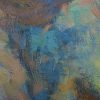J.P. Harrington, who died in 1961 at the age of 77, is known among linguists as one of the most prolific collectors and curators of our field. His unusual personality aside, he is recognized for having amassed an astounding collection of written transcriptions of Native American languages, altogether about a million pages and notes. In the course of collecting language data, he also appropriated the material culture of the communities he visited, from their shell beads used for currency to woven baskets and ceramics, and stored them along with labels and descriptions of them in the native language. You can find today at smithsonian.org a photographic inventory of the many objects Harrington collected, along with notes describing their size and function.
Harrington began his career working with Chumash, a collection of 8 related languages, spanning about 6,400 square miles along the American west coast. At its peak, Chumash was spoken by about 15,000 speakers. By 1839, this number had declined to fewer than 250 surviving speakers due to disease and neglect. Shortly after Harrington decided to expand his work to include more Native American languages, leading him to travel throughout the Southwest and up the coastal areas of the United States to Alaska, recording speakers of over 50 different American Indian languages.
Described as brilliant, but also paranoid and obsessive, he did not do much inventorying of his materials; objects and transcriptions alike were thrown together haphazardly and stored in postal bags that he would carry with him. Once full, he would leave the bags for storage in various places throughout the west coast. Many of them he forgot about and later were discovered after his death when caretakers contacted the family to ask for payment of storage costs. The sheer amount of work he produced in his lifetime is described as occupying nearly 700 feet of archival space across multiple institutions.
For this meeting Michael Schudson asked if I could say something about the digital curation of language, as an example of ubiquitous and ephemeral phenomena that presents curatorial challenges. It was then that I was reminded of a story told to me by a fellow graduate student at UCSD who had travelled to the Smithsonian to work with Harrington’s linguistic data. As I remember it, she told me that most of his written transcriptions had yet to be organized and catalogued. She spent weeks going through his materials, searching for any kind of notes he had made about Diegueño, a language of the San Diego region that she was studying for a dissertation about auxiliaries. She said that when these postal bags were first opened by archivists, all sorts of materials were found: written notes, plants, and once—a desiccated bird, with a tag hanging from the feet explaining how to pronounce it, in phonetic transcription. All sorts of materials were found: written notes, plants, and once—a desiccated bird, with a tag hanging from the feet explaining how to pronounce it, in phonetic transcription.
This strikes me as a supreme example of curating things that are material and not at all digital. In their original forms, they existed along with the dust and detritus that accompanied the life of an archivist who spent every waking hour collecting, amassing, recording, and storing as much as he possibly could. He was driven by the immediacy and urgency of his mission; at one point he decided he should sleep less, so that he could collect and record even more. He was said to have worked 18 hours a day, as driven as he was by the enormity of the task he had assigned to himself, to record languages he knew would soon become extinct. Today, the Smithsonian has digitized much of his archives and placed numerous pages online, where viewers can easily access photographs and descriptions of Native American objects.
Returning to the challenge of digital curation, I wonder what we lose when we deemphasize material storage and turn to digital records instead. I can imagine being at the Smithsonian and opening a dusty postal bag once carried by Harrington filled with, like the proverbial treasure chest, dried-up odd things, and yellowed pages thrown in haphazardly. He so assiduously recorded everything he could—words, sentences, and stories of his informants and subjects—that the details remain still enormously useful and relevant for each generation of scholars in the years since his death. I wonder if they treated his boxes and bags as an archaeological site, how they looked when they arrived, and what was inside, at the bottom or at the top. (Did they photograph the interiors of these hastily assembled storage objects?) The story of these archives is of course about the materials themselves, but also about the curator and the curatorial drive that possessed him. The story of these archives is of course about the materials themselves, but also about the curator and the curatorial drive that possessed him.
My work for the last ten or twelve years has been to record and analyze the emergence of a new sign language used in a community of Bedouins in southern Israel. When I first visited the community in 2000, along with my research colleagues, I was struck by how widely used the sign language was, that it was used not only by deaf members of the families in the village, but by their hearing relatives: husbands and wives, siblings, and their children. In a village of about 3500 residents, about 100 are deaf, and because of the profile of genetic deafness in the community, deaf people do not all live in one family, but are interspersed across nearly all families in the village.
We quickly realized at our first visit that this was an unusual opportunity (new sign languages are not extremely rare; there are numerous such cases around the world) to study the conditions under which hearing speakers will communicate manually, and together with their deaf relatives, spontaneously create a new language out of the fabric of everyday gesture. In the first few homes I visited, I noticed speakers seamlessly shifting from Arabic, and sometimes Hebrew to my hearing colleagues, to signing with deaf members of the household. The Bedouins of this village have large families, so deaf children rarely ever grow up alone, as they often do in Western societies: they grow up with deaf siblings and hearing siblings. For the first few years when I worked in the village, I couldn’t always tell who was deaf or who was hearing. Many of the hearing siblings sign as well as their deaf age mates.
Almost immediately we began to discuss how to record and store this new sign language. We know from communities around the world that sign languages are generally fragile, unless they have schools and other institutions to support transmission across generations of signers. We know from communities around the world that sign languages are generally fragile, unless they have schools and other institutions to support transmission across generations of signers. American Sign Language is said to have originated about 200 years ago, when the first public school for deaf children was founded in Hartford, Connecticut in 1817. I’m seven generations removed from the origins of this sign language, having learned it from my parents, and my father from his parents who were students at the Illinois School for the Deaf in Jacksonville. When we arrived in 2000, the sign language in the village was just three generations deep, and many of the young adults had been to deaf schools near Tel Aviv where they learned a second sign language–Israeli Sign Language–which has in its origins some German Sign Language, brought to Israel by deaf Jewish immigrants. Today some young deaf signers say they prefer ISL over the village sign language because it gives them linguistic mobility in Israel, allowing them to communicate across religious and ethnic groups, and with Bedouins who live in other parts of Israel (and would not know the village sign language).
We knew we had to record the sign language and preserve our record for a time when the village sign language, which we call Al-Sayyid Bedouin Sign Language (ABSL) might no longer exist. We store our digital video data in two universities, at UCSD, and the University of Haifa. We use high-definition digital cameras, which we transfer for storage on university servers. We have recorded responses to experimental tasks and elicitations. We have recorded free conversation between pairs of signers, and stories told by individual signers, both deaf and hearing. We have some transcription of signing into English glosses and translations, using Elan, software that was developed at the Max Planck Institute for detailed written records of spoken language video data. Elan adapts easily to sign language data. Where in the past we might have had challenges notating video data, now it is much more commonplace to make video recordings of speakers as well as signers.
We have begun talking with endangered languages centers around the world about how we might include our video materials and transcriptions in their archives. We adhere to university protocols for protecting human subjects. The men have given us permission to use photographs of them, but the young women tell us that we cannot use their images in publications or presentations where they might be uploaded onto the Internet. We are always vigilant about digital images that might accidentally be released to the public, maybe by someone using an iPhone camera at one of our talks.
I’ve had occasion to think about how my own data collection compares to Harrington’s. I have a great deal of digital volume, but he has far more material volume. He has birds, baskets, and pottery. I took pictures of objects around the home, and asked them to name each with a sign. I would never have asked for permission to carry away their cooking utensils, hand-stitched traditional wedding clothing, or woven tapestries. That would have been too aggressive, and could have provoked ownership issues. Harrington probed into everyday practices of Native Americans and wrote down their spoken sentences in phonetic transcription; I engaged the signers in conversations on video, and asked them to describe a typical day. Our digital records are archive-friendly, making them easy for transfer between our labs and universities, using FTP and Dropbox. We extract and combine individual video clips for talks, experiments, and lab discussions.
Thinking again about Harrington, my work seems almost antiseptic in comparison; there is no desert dust, detritus, or unusual odors when we turn on our desktop computers. We have transformed real-life language contexts into digital storage, cleanly available and readily transferable. In our high-definition data, we seem to be low-definition when it comes to material culture. If we didn’t photograph or videotape it, we didn’t take it with us. This strikes me as a loss of sorts, one we ought to acknowledge. At a local flea market in Israel, I bought a Bedouin basket for threshing wheat, and it is a decorative object in my house. Curation is about the curator; Harrington’s curation is about him as a curator, and what he desired to do. Today’s digital storage erases the curator, as pieces and images are extracted, combined, and recombined by many different people for different purposes. With each digital generation, as images move almost effortlessly across platforms, we seem to erase more and more of the context of the collection, and the desire of the collector. That is as much a part of the historical record as what is found in Harrington’s boxes and trunks.
Flickr photo Archives by Wikimedia Finland, shared under a Creative Commons (BY) license.













